What Causes It?
Weakening of the lower esophageal sphincter (LES)
Hiatal hernia (a condition where part of the stomach pushes up through the diaphragm)
Obesity or pregnancy (which increase pressure on the abdomen)
Certain foods and beverages (spicy, fatty, or fried foods, citrus, tomatoes, chocolate, coffee, alcohol)
Smoking
Certain medications (aspirin, ibuprofen, certain muscle relaxers, blood pressure medications)
Eating large meals or lying down right after eating
Stress and anxiety
Delayed stomach emptying
Connective tissue disorders like scleroderma
Signs & Symptoms
Heartburn (a burning sensation in the chest that may spread to the throat)
Regurgitation of food or sour liquid
Difficulty swallowing (dysphagia)
Feeling like there's a lump in your throat
Chronic cough, especially at night
Laryngitis or hoarseness
Disrupted sleep
New or worsening asthma
Chest pain (which may be confused with heart attack)
Bad breath
Nausea and vomiting
Wearing away of tooth enamel due to excess acid
